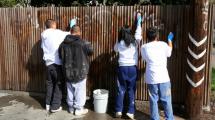Youth who receive special education services under the Individuals with Disabilities Education Act (IDEA 2004) and especially young adults of transition age, should be involved in planning for life after high school as early as possible and no later than age 16. Transition services should stem from the individual youth’s needs and strengths, ensuring that planning takes into account his or her interests, preferences, and desires for the future.
Child Welfare
LGBTQ+ youth enter the child welfare system for reasons like those of other children and youth — that is, their birth families cannot provide a safe, stable, and nurturing home. In some cases, families reject, neglect, or abuse young people when they learn that they identify as LGBTQ+ or are questioning their romantic/sexual orientation or gender identity.
LGBTQ+ youth are overrepresented in child welfare systems, even though they are likely to be underreported because they risk harassment and abuse if their LGBTQ+ identity is disclosed. Studies have found that about 30 percent of youth in foster care identify as LGBTQ+ and 5 percent as transgender, in comparison to 11 percent and 1 percent of youth not in foster care.1 Furthermore, LGBTQ+ youth of color are disproportionately overrepresented in the child welfare system and stay longer in child welfare systems, while also having an increased risk of experiencing discrimination and violence compared to their peers.2
Experiences of LGBTQ+ Youth in Child Welfare Systems
LGBTQ+ youth may experience challenges under the care of child welfare systems. Unfortunately, a high percentage of LGBTQ+ youth continue to experience verbal harassment or physical violence after they are placed in out-of-home care due to conflicts related to their sexual orientation or gender identity.3 In the Los Angeles study, 13 percent of LGBTQ+ youth reported being treated poorly by the foster care system, compared with 6 percent of non- LGBTQ+ youth.4
Many LGBTQ+ youth experience multiple disrupted placements, compounding the trauma associated with leaving their families of origin and increasing the chances of homelessness.5 For example, 78 percent of LGBT6 youth in one study were removed or ran away from foster placements because of the caregiver’s hostility toward their sexual orientation or gender identity.7 Furthermore, as noted in the homelessness and housing section of this topic, the streets are home to a disproportionate number of youth who are LGBTQ+. Some estimates suggest that the percentage of youth who are homeless and LGBTQ+ could be as high as 40 percent.8 Other research has found that as many as 56 percent of LGBT youth in out-of-home care have spent some time without stable housing because they felt safer on the streets than in group or foster homes.9
One study found that 65 percent of LGBT youth experiencing homelessness had lived in group or foster homes and that 39 percent of these youth had been forced to leave their homes because of their sexual orientation or gender identity.10 Furthermore, LGBT youth in foster care are less likely than other youth to find a permanent home, whether through reunification with their birth or kin families or through adoption.11 The resources at the end of this section can inform the efforts of child welfare systems to improve policies, practices, and outcomes for LGBTQ+ youth and their families.
Supporting LGBTQ+ Youth in Child Welfare Systems
Professionals who work with youth need to understand the lives and unique challenges of the LGBTQ+ youth they serve and the implications of policies, practices, and organizational climates on their experiences and outcomes. Many resources are available for caregivers and others in the child welfare workforce to develop competencies and to understand what to expect and how to talk about and positively address issues that affect LGBTQ+ youth, including providing safe and supportive environments (with families or in group or foster homes). Like all youth, LGBTQ+ youth need a safe and stable place to live, freedom to express themselves, and structure and guidance to support them in becoming responsible, healthy adults.
Given this, the Children’s Bureau of the U.S. Department of Health and Human Services’ Office of the Administration for Children & Families has invested funding in the Los Angeles LGBT Center’s RISE (Recognize Intervene Support Empower) Initiative, which serves as an example of an approach for supporting LGBTQ+ youth in child welfare systems. RISE aims to improve permanency for LGBTQ+ children and youth in the foster care system by assessing disproportionality and disparities in Los Angeles (PDF, 82 pages) and reducing heterosexism, anti-gay, and anti-transgender bias. RISE focuses on LGBTQ+ children and youth ages five to 19 with open cases at the Los Angeles County Department of Children and Family Services (L.A. County DCFS), including those who are gender non-conforming and gender-questioning. RISE’s partners include the L.A. County DCFS and more than 20 community organizations. The initiative has three components so that LGBTQ youth in Los Angeles (1) find durable family connections, (2) achieve emotional permanency, and (3) obtain legal permanency in homes where they feel safe, nurtured, and loved into adulthood.
Supporting Families in Child Welfare Systems
Child welfare systems can work with the families of origin of LGBTQ youth to support reunification. This may include, for example, connecting these families and youth to counseling services that help to address challenges the family may be experiencing.
Resources for Recruiting and Supporting LGBTQ+ Families
A growing number of adoption agencies and professionals are proactively welcoming LGBTQ+ adoptive families. These families represent a pool of highly motivated and qualified prospective foster and adoptive parents and expand the options for permanency for youth. However, in many parts of the country, LGBTQ+ communities remain largely untapped as resources for adoption services. Targeted efforts are necessary to reduce barriers to families who want to adopt youth, including those who are LGBTQ+.
Adoption by Family Type: LGBTQ Families
Many gay and lesbian families adopt children domestically and through inter-country adoption. This webpage provides information on and resources about adoption by LGBTQ families.
LGBT Foster and Adoptive Families: Finding Children Forever Homes (PDF, 8 pages)
This publication highlights the need to find adoptive families for waiting children, provides an overview of the barriers faced by LGBT families who want to foster and adopt, and includes targeted recommendations designed to ensure that LGBT families can help to fill the need for loving and stable foster and adoptive homes for children.
Promising Practices in Adoption and Foster Care
This tool outlines best practices for welcoming all prospective adoptive parents, regardless of their sexual orientation, gender identity, or gender expression.
Tips for Child Welfare Professionals: Talking About LGBT-Headed Families (PDF, 2 pages)
This publication provides child welfare professionals with considerations and guidance for talking to and about LGBT-headed resource families to birth families about their child joining an LGBT-headed family, as well as for talking to children/youth about becoming part of an LGBT-headed family.
Working with LGBTQ+ Families in Adoption
This resource for child welfare professionals provides tips for effectively recruiting and retaining LGBTQ+ adoptive families, overcoming challenges faced by LGBTQ+ adoptive parents, and creating a welcoming agency for them.
Resources for Birth Families, Foster Families, and Caregivers of LGBTQ+ Youth
All Children — All Families
This project promotes LGBTQ cultural competency among child welfare agencies through resources such as an online agency self-assessment tool, comprehensive staff training, and free technical assistance.
Answers to Your Questions about Transgender People, Gender Identity, and Gender Expression (PDF, 6 pages)
This document provides information about the difference between biological sex and gender, as well as about gender identity/expression and transgender identity.
Answers to Your Questions for a Better Understanding of Sexual Orientation and Homosexuality
This document provides information about sexual orientation and the impact of prejudice and discrimination on those who identify as lesbian, gay, or bisexual.
National Center for Child Welfare Excellence: LGBTQ Parents in Child Welfare
This website provides various resources, including recommended practices and research, related to LGBTQ parenting and families.
Parents, Families and Friends of Lesbians and Gays (PFLAG)
This website provides resources, events, and information on local chapter support groups.
Resources for Families of LGBTQ+ Youth
This webpage provides information about organizations, tip sheets, and other resources to help families support their LGBTQ+ youth, understand what to expect, and learn how to talk about issues that may be impacting their youth.
Supporting Your LGBTQ+ Youth: A Guide for Foster Parents (PDF, 15 pages)
This fact sheet helps foster parents learn about LGBTQ+ and questioning youth in the child welfare system, addresses common misconceptions about sexual orientation and gender identity, teaches foster parents about the unique risks that LGBTQ+ and questioning youth face and the important role they can play in reducing those risks, provides tips for creating a welcoming home for youth, and includes links to additional resources.
Supportive Families, Healthy Children: Helping Families with Lesbian, Gay, Bisexual, and Transgender Children (PDF, 24 pages)
This publication — which is available in English, Spanish, and Chinese — provides information on how families can help to support their LGBT children, using a research based, culturally grounded approach to help families decrease rejection of and increase support for their LGBT children.
Resources for Child Welfare Professionals Who Work with LGBTQ+ Youth
Addressing the Needs of LGBTQ Youth in Foster Care (PDF, 8 pages)
This newsletter article discusses the importance of addressing the needs of LGBTQ and questioning youth in foster care and the challenges and risks these youth encounter in care. It also describes what youth-serving agencies such as Court Appointed Special Advocates (CASA) for Children are doing to support this population and what resources CASA volunteers can turn to when working with LGBTQ and questioning youth.
All Children — All Families Project
This project promotes LGBTQ cultural competency among child welfare agencies through resources that include an online agency self-assessment tool, comprehensive staff training, and free technical assistance.
Caring for LGBTQ Children & Youth: A Guide for Child Welfare Providers
This reference guide includes the information, tips, and terminology that providers must know when caring for LGBTQ and questioning youth in out-of-home care. It also includes recommendations for promoting the safety, permanency, and well-being of LGBTQ children and youth.
Child Welfare League of America (CWLA) Best Practice Guidelines: Serving LGBTQ+ Youth in Out-of-Home Care (PDF, 96 pages)
This resource contains a set of comprehensive professional guidelines for how child welfare and juvenile justice professionals can best serve LGBTQ+ youth in state care.
Creating Inclusive Services for LGBT Youth in Out of Home Care: Training Resources (PDF, 11 pages)
This training resource assists child welfare trainers in conducting trainings for their agencies to create inclusive policies and services for LGBT youth.
Creating LGBTQ Affirming Agencies
This video and guide builds state and territorial capacity to create culturally inclusive environments within child welfare agencies for LGBTQ individuals.
getREAL (Recognize. Engage. Affirm. Love)
This initiative promotes the healthy development of all children and youth, with a focus on sexual orientation, gender identity, and expression. getREAL challenges public systems working with children and youth to improve their policies and practices to support the healthy sexual and identity development of all children and youth in child welfare systems.
Getting Down to Basics: Tools to Support LGBTQ Youth in Care (PDF, 48 pages)
This toolkit provides guidance on issues that affect LGBTQ youth in out-of-home care and information for providers on providing support and services.
A Guide for Understanding, Supporting, and Affirming LGBTQI2-S Children, Youth, and Families (PDF, 8 pages)
This guide provides information for service providers, educators, allies, and community members who seek to support the health and well-being of children and youth who are lesbian, gay, bisexual, transgender, questioning, intersex, or two-spirit (LGBTQI2-S) and their families. This guide supports efforts to promote full and affirming inclusion of LGBTQI2-S youth and families in communities and provider settings (e.g., schools, child welfare, juvenile justice, mental health). The guide includes a section for organizations to add their endorsement electronically. Both the National Association of School Psychologists (NASP) and the National Association of Social Workers have endorsed the guide.
Guidelines for Managing Information Related to the Sexual Orientation & Gender Identity and Expression of Children in Child Welfare Systems (PDF, 26 pages)
This publication proposes standards for sharing information on the sexual orientation and gender identity and expression of children and youth in child welfare systems.
Information Memorandum: Lesbian, Gay, Bisexual, Transgender, and Questioning Youth in Foster Care (PDF, 5 pages)
This resource encourages child welfare agencies, foster and adoptive parents, and others who work with young people to ensure that all children are protected and supported while they are in foster care.
LGBTQ Children and Youth in Child Welfare
This website provides various resources — including recommended practices, research, and training materials — related to LGBTQ and questioning young people in child welfare systems.
Moving the Margins: Curriculum for Child Welfare Services With Lesbian, Gay, Bisexual, Transgender, and Questioning Youth in Out-of-Home Care (PDF, 156 pages)
This train-the-trainer manual provides training to build the capacity, awareness, and skills of social workers and other child welfare practitioners to better serve and respond to the needs of LGBTQ and questioning youth. The curriculum includes information on risks, challenges, and strengths specific to LGBTQ and questioning youth and their caregivers. This resource addresses practices related to managing confidential information; enhancing skills to intervene with biological, adoptive, and foster parents; addressing differential treatment in child welfare agencies; and addressing the needs of transgender youth.
Opening Doors for LGBTQ Youth in Foster Care
This website provides the legal and child welfare communities with tools, resources, and other supports for improving outcomes for LGBTQ and questioning young people in foster care. The site includes information on the rights of LGBTQ and questioning young people in care and offers recommendations for balancing personal beliefs with professional responsibilities.
A Practitioner's Resource Guide: Helping Families to Support Their LGBT Children (PDF, 18 pages)
This resource provides information and resources to help practitioners in health and social service systems implement best practices in engaging and helping families and caregivers to support their LGBT children.
Providing Services and Supports for Youth who are Lesbian, Gay, Bisexual, Transgender, Questioning, Intersex or Two-Spirit (PDF, 8 pages)
This practice brief is intended for policymakers, administrators, and providers across all systems of care who are seeking to learn more about LGBTQI2-S youth and system-level strategies for providing more culturally and linguistically competent services for these youth.
Recommended Practices to Promote the Safety and Well-Being of Lesbian, Gay, Bisexual, Transgender and Questioning (LGBTQ) Youth and Youth at Risk or Living With HIV (PDF, 20 pages) in Toolkit to Support Child Welfare Agencies in Serving LGBTQ Children, Youth, and Families
This toolkit helps states and territories adapt their policies and practices to meet the growing needs of LGBTQ children, youth, and families. It provides links to knowledge and skill building resources, including articles, videos, tools, training curricula, tip sheets, information briefs, websites, and other products. The “Recommended Practices” resource for child welfare agencies provides guidance about ensuring safe and appropriate care when addressing the unique needs of LGBTQ and questioning young people in the child welfare system.
Working with LGBTQ+ Youth and Families
This webpage provides information about serving children, youth, and families in child welfare systems as well as resources for youth and their families.
Resources for LGBTQ+ Youth in Child Welfare Systems
The Economic Well-Being of Lesbian, Gay, or Bisexual Youth Transitioning Out of Foster Care
This resource discusses the well-being of LGB youth aging out of foster care and compares data with their heterosexual peers. Data come from a longitudinal study, the Midwest Study of Adult Functioning of Former Foster Youth.
It’s Your Life: Improving the Legal System’s Approach to LGBTQ (PDF, 32 pages)
This handbook and website help LGBTQ youth in foster care navigate child welfare systems. It includes tools and supports to understand their rights and what they can expect from child welfare professionals.
Know Your Rights: LGBTQ Youth and Youth Living with HIV in Foster Care and Juvenile Justice Systems
This guide informs LGBTQ youth of their rights in the foster care and juvenile justice systems, including their rights to feel safe, to be treated equally, and to access services and supports without discrimination.
National Resources for LGBTQ Youth
This resource sheet summarizes various national resources (e.g., schools and organizations in the child welfare, health, and mental health systems) for LGBTQ youth.
Resources for LGBTQ+ Youth in Out-of-Home-Care
This webpage helps LGBTQ+ youth answer questions related to their out-of-home care experience and includes information on organizations that support LGBTQ+ youth.
References
1Baams, Wilson, & Russell, 2019; Matarese et al., 2021; Sandfort, 2020
2 Huggins et al., 2019; Conron & Wilson, 2019; Wilson & Kastanis, 2015
3 Courtney, Dworsky, Lee, & Raap, 2009; Mallon, Aledort, & Ferrera, 2002
4 Wilson, Cooper, Kastanis, & Nazhad, 2014
5 Wilson, Cooper, Kastanis, & Nazhad, 2014
6 If the acronym ‘LGBT’ is used to describe a study’s focus then those are the groups included in the study.
7 Feinstein, Greenblatt, Hass, Kohn, & Rana, 2001
8 Sullivan, Sommer, & Moff, 2001; Feinstein, Greenblatt, Hass, Kohn, & Rana, 2001; Durso & Gates, 2012
9 Mallon, 1998
10 Berberet, 2006
11 Sullivan, Sommer, & Moff, 2001
Other Resources on this Topic
Announcements
Briefs
Collaboration Profiles
Feature Articles
Publications
Resources
Technical Assistance
Tools & Guides
Videos & Podcasts
Websites
Youth Topics
Youth Briefs
Research links early leadership with increased self-efficacy and suggests that leadership can help youth to develop decision making and interpersonal skills that support successes in the workforce and adulthood. In addition, young leaders tend to be more involved in their communities, and have lower dropout rates than their peers. Youth leaders also show considerable benefits for their communities, providing valuable insight into the needs and interests of young people
Statistics reflecting the number of youth suffering from mental health, substance abuse, and co-occurring disorders highlight the necessity for schools, families, support staff, and communities to work together to develop targeted, coordinated, and comprehensive transition plans for young people with a history of mental health needs and/or substance abuse.
Nearly 30,000 youth aged out of foster care in Fiscal Year 2009, which represents nine percent of the young people involved in the foster care system that year. This transition can be challenging for youth, especially youth who have grown up in the child welfare system.
Research has demonstrated that as many as one in five children/youth have a diagnosable mental health disorder. Read about how coordination between public service agencies can improve treatment for these youth.
Civic engagement has the potential to empower young adults, increase their self-determination, and give them the skills and self-confidence they need to enter the workforce. Read about one youth’s experience in AmeriCorps National Civilian Community Corps (NCCC).






